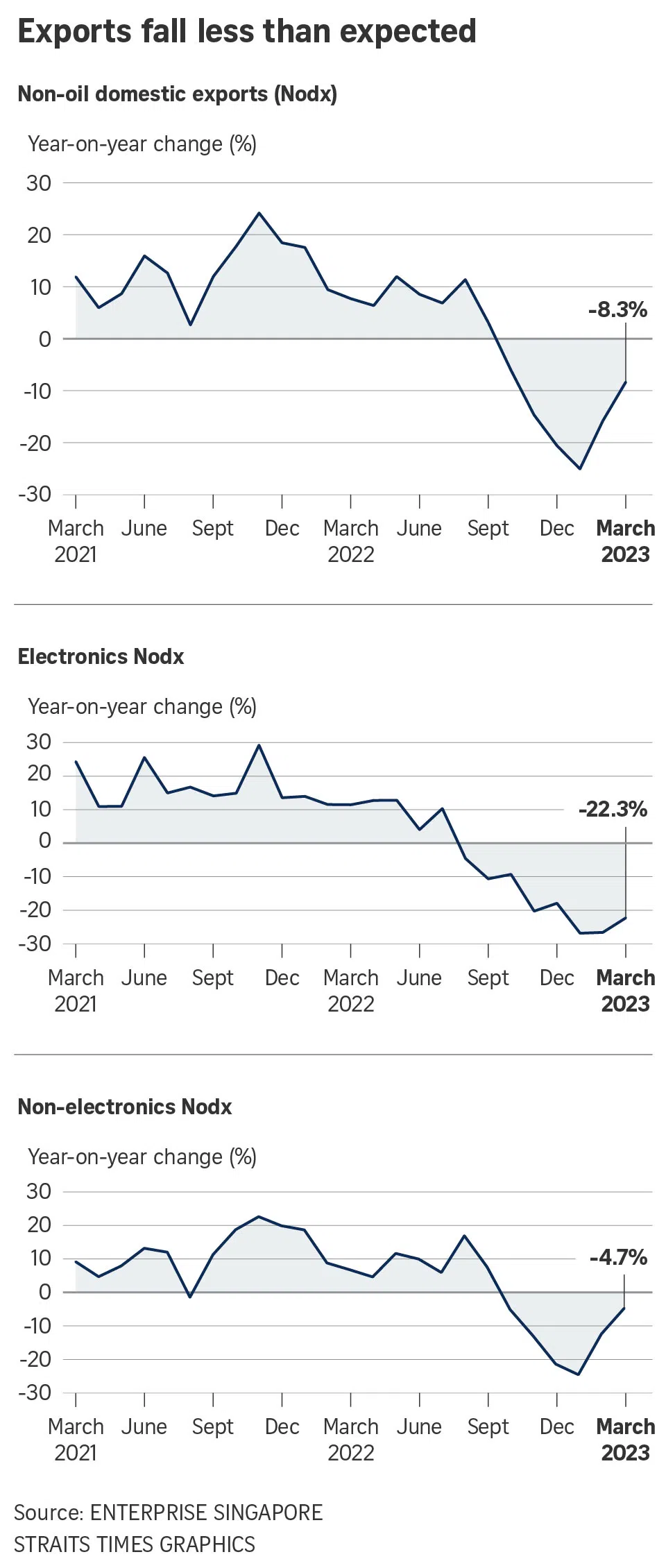S’pore key exports surprise with smaller drop in March but economists see slump dragging on
Sign up now: Get ST's newsletters delivered to your inbox

Singapore’s non-oil domestic exports fell 8.3 per cent on a yearly basis in March following a revised 15.8 per cent contraction in the month before.
ST PHOTO: GIN TAY
Follow topic:
SINGAPORE – Singapore’s key exports posted a much smaller drop than expected in March, but economists say that while the worst may be over, the outlook remains gloomy.
Exports are likely to remain around current weak levels in the coming months, with the United States and the euro zone tipped for a recession, they added.
Much will depend on China – Singapore’s single biggest export market – where demand has not yet picked up despite the reopening of borders, they noted.
Singapore’s non-oil domestic exports (Nodx) fell 8.3 per cent year on year in March, following a revised 15.8 per cent contraction in February, data from Enterprise Singapore (EnterpriseSG) showed on Monday. Year on year, Nodx has shrunk for six straight months.
The March contraction also brought the fall in Nodx to 16.2 per cent for the first quarter, said OCBC Bank.
But the 8.3 per cent drop was less than half the 19.4 per cent fall forecast by economists in a Bloomberg poll. It was also the smallest decline in recent months – Nodx fell 25 per cent in January and 20.6 per cent in December.
Compared with the previous month and seasonally adjusted, Nodx in fact grew by 18.4 per cent in March, reversing February’s 8.2 per cent decline.
Mr Shivaan Tandon, emerging Asia economist at Capital Economics, said March’s performance was driven by a “strong increase” in chemical and pharmaceutical exports to both the European Union and North America.
But he added that the data does not suggest “a strong recovery for exports in the near term”.
“We expect both the US and euro zone economies to undergo a recession this year, which will weigh heavily on Singapore’s Nodx,” Mr Tandon said.
According to EnterpriseSG data, the US and Europe together accounted for 30.2 per cent of Singapore’s Nodx in the January to March quarter.
Both electronics and non-electronics exports fell in March – with electronics accounting for a bigger share of the contraction.
Electronics shipments fell 22.3 per cent in March, somewhat better than the 26.5 per cent contraction in February.
The decline in electronics Nodx was led by disk media products at 41 per cent, parts of personal computers (36 per cent) and integrated circuits (28.6 per cent).
OCBC chief economist Selena Ling said this suggests that the current global semiconductor industry downturn remains a drag on the sector.
Non-electronics exports fell by a smaller percentage in March, down 4.7 per cent year on year.
This was a better performance than February’s 12.4 per cent decline.
The volatile pharmaceuticals sector rebounded 26.8 per cent, but petrochemicals fell 23.1 per cent and food preparations fell 24.2 per cent.
Breaking down the numbers by export markets, Nodx to the top markets as a whole declined in March. The declines were led by China, Taiwan and Malaysia.

Exports to China fell further into the red, down 14.1 per cent due to the drop in shipments of petrochemicals, pharmaceuticals and integrated circuits.
China accounted for a 14.6 per cent share of Singapore’s Nodx in January to March, according to the EnterpriseSG data.
ANZ head of Asia research Khoon Goh said he was not surprised that exports to China continued to contract because the current rebound in the Chinese economy is driven by domestic consumption and services.
He said goods exports to China will start to pick up from mid-year and this “should be reflected in Singapore’s export data by then”.
Maybank economists Chua Hak Bin and Lee Ju Ye said in their report that if demand from China still fails to pick up by then, “Singapore risks entering into a technical recession”.
Intra-regional trade also weakened as exports to Indonesia and Malaysia fell by more than 20 per cent and exports to Thailand dipped into the red.
Shipments to the European Union similarly remained in the red, although the fall was smaller in March at 7.9 per cent.
The only two markets where Nodx rose were the US and South Korea.
Shipments to the US continued to rise by another 13.2 per cent in March, while shipments to South Korea reversed February’s losses to rise 3.1 per cent in March.
Maybank is maintaining its forecast for Nodx growth in 2023 at between minus 7 per cent and minus 4 per cent.
Dr Chua and Ms Lee said “global demand will likely stay weak amid tight monetary policy in advanced economies and vulnerabilities in the financial system following the banking turmoil in the US and Europe”.
UOB senior economist Alvin Liew said the broad-based weakness in both electronics and non-electronics performance continued to weigh negatively on manufacturing demand for Singapore.
He expects global demand to remain weak on the back of further monetary policy tightening and worries about economic slowdown in the developed markets.
UOB is sticking to its forecast for Nodx to contract by 5.5 per cent in 2023.
The Government’s Nodx forecast for 2023 is for minus 2 per cent to 0 per cent growth.


